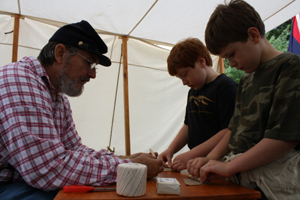
Jim Fouts, of St. Albans, a well-known Union soldier re-enactor locally, teaches Ian Lindberg, 9, (center), and Charlie Fenn-Smith (right), of Hampstead, N.H., to roll a paper cartridge for a Civil War rifle.
It’s one thing to read about history in a textbook, but to witness Union and Confederate re-enactors bring the Civil War to life was a thrilling experience for the many who turned out for the St. Albans Civil War Heritage Days, held in Taylor Park on Saturday and Sunday, July 30 and 31.
“For me it’s like talking to history itself,” said Wayne Russell, of Richmond, Texas, on Saturday, the busier of the two days.
Russell, who served in the U.S Marines just as the Vietnam War was coming to an end, said he had an uncle who was in Pearl Harbor, and another who fought in Germany, and has always been a history buff. He considered himself lucky to have been able to attend this year’s event sponsored by the Champlain Valley Reenactors and the St. Albans Historical Museum.
Russell said he maximized his experience by walking around the simulated camp talking to those who portrayed soldiers from both sides of the war to get the whole story.
As a rifle was fired nearby, Russell reflected upon his feelings about Independence Day.
“We celebrate on July Fourth, but a lot of people died for this day. When I hear the fireworks I am hearing artillery and remembering the people who were dying.
“It amazes me to think about how these soldiers walked along through the woods, pulling cannons, and how little they had,” Russell said.
Little food, limited medical supplies, no soap and hot water, made it a wonder soldier could even survive the travel, let alone the battles, Russell mused.
Not only was the Civil War about freedom, it was also a valuable learning tool in a multitude of ways.
Re-enactor Steve Smith, of St. Albans, who was instrumental in organizing the event, stood by a camp fire, salt pork sizzling in an old fry pan, telling visitors that although it appears unappetizing, it was a staple that kept many soldiers going.
“Think about it,” Smith told a few children who had their noses curled up at the sight, “soldiers were walking the countryside, making camp where they could, veggies were pretty hard to come by.”
Poor diets also meant poor dental health, and over at the medical exhibit visitors were in awe over the primitive instruments and tales of how they were used.
Pliers, knives and amputation saws helped illustrate the stories told by Dan Celik, of Brandon, who is with the Civil War Medical Coalition.
Celik portrayed Melvin Hyde, a surgeon, born in Grand Isle, who later lived and practiced in Isle LaMotte. His wife, Laurie, portrayed Hyde’s wife, Phoebe, and also wore period clothing
According to Celik, amputations were quite popular as a life-saving measure during that time.
At least those who underwent amputation stood a chance, unlike the wounded that were sent away with horrific wounds to what was dubbed “the dying tree,” Celik said.
He explained that there was just no time to deal with soldiers that had been shot in the head or abdomen; they were considered as too seriously wounded and unlikely to survive, so the priority was to save the “savable” soldiers.
Being treated did not guarantee survival, for as Celik explained; there was an extremely high risk for infection, because the medical instruments were only cleaned at night.
“They would use the same tools over and over, from one patient to the next,” he said.
“You had the best chance of survival if you were lucky enough to be the first to see the surgeon.”
“They were not good conditions,” said Celik, “but we learned from that, and in reality, that’s why we are where we are today.”
“There were no antibiotics, and most of our medications were ineffective,” said Bob Tillson.
He and his son, Evan were portraying two brothers, William “Steptoe” and Richard Allen Christian, who were Confederate surgeons from Virginia.
“We were surgeons, but we were more like warriors,” Tillson explained of their roles.
“The brothers started a cavalry, they were in the mindset of wanting to defend their home,” Tillson added.
“Now, at the time surgeons had just two forms of anesthesia. We had chloroform or ether,” Tillson said, “and you couldn’t use ether at night.”
“Why not?” someone from the crowd asked.
“Well we would blow ourselves up. We operated by candlelight and ether is highly explosive,” he explained, raising many eyebrows.
He continued to wow those assembled to hear his stories by adding that one surgeon would have to deal with several hundred wounded men, and often worked for 72 hours straight.
“If that happened now, it would be a ‘union’ violation,” he said. After a short, reflective pause, Tillson laughed in spite of the words he had chosen and added that no pun had been intended.
Darryl Bachand and his wife, Lisa were among the many who were enjoying the event.
“Now I was born in Tennessee and my folks live in Virginia,” he said, so it was interesting for him to experience a Civil War reenactment in Vermont – on the other side, so to speak.
Lisa Bachand said she wished the event could be larger and last longer. She feels that part of history has been lost in that it is a historical period that is not introduced as much as it was in her schooldays.
Such an event is planned for September 2014, when St. Albans will stage the largest Civil War re-enactment event ever in Northwestern Vermont, the recreation of The St. Albans Raid (visit www.stalbansraid.com for more).
“We were exposed to it in grade school,” said Mrs. Bachand, now they only really get into it at the high school level.”
She feels it is important to teach today’s children about how the Civil War ties into our local history.
“There is a lot of history right here,” she said
The Bachands’ daughter, Bridget, a junior at Bellows Free Academy, clearly showed her passion for history, attending the event dressed in a Revolutionary War costume, depicting Alfred F. Jones from “The Personification of America.”
She wore an ear-to-ear smile after having fired the 1861 Springfield Rifle being demonstrated by Jacob Woodward.
“This was the most commonly used firearm during the Civil War,” the 21-year-old re-enactor explained.
“The Union Army mass-produced their weapons,” he added. “Our military today commonly uses the M-4, this is the M-4 of it’s time,” Woodward said holding out his rifle.
“This event is a great thing for St. Albans, it draws in a lot of people and creates an interest in the history of this town,” added Woodward, who had already joined company drills, a weapons’ inspection, and a booming firing line ringed by an appreciative crowd on Taylor Park.
Woodward said that rather than just sitting in a classroom, those attending the St. Albans Civil War Heritage Days “get to experience what they are learning.”
By ANN HAWKSBY
St. Albans Messenger Correspondent



